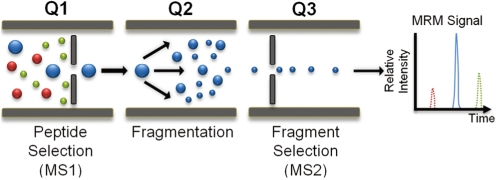LC-MS/MS MRM Analysis Service
LC-MS/MS MRM Analysis Service utilizes liquid chromatography-tandem mass spectrometry (LC-MS/MS) in Multiple Reaction Monitoring (MRM) mode to achieve highly sensitive and specific quantification of target molecules. MRM mode selects specific precursor-product ion pairs, focusing on the dynamic changes of target molecules. LC-MS/MS MRM analysis enables high-precision quantification of low-abundance molecules in complex biological samples and is widely applied in metabolite quantification, targeted protein quantification, and drug development. Leveraging advanced chromatography and mass spectrometry platforms, MtoZ Biolabs offers tailored LC-MS/MS MRM Analysis Service to support life science research and the advancement of precision medicine.

Boja E S. et al. The Korean Journal of Laboratory Medicine. 2011.
Analysis Workflow
General workflow of LC-MS/MS MRM analysis:
1. Sample Preparation
Select appropriate methods based on sample type (e.g., protein precipitation, solid-phase extraction) to perform proper sample pretreatment.
2. Liquid Chromatography Separation
Use high-performance liquid chromatography (HPLC) to separate target molecules, minimizing interference from co-eluting compounds in complex samples.
3. Mass Spectrometry Analysis
Monitor specific ion pairs of target molecules using the MRM mode and record their signal intensities.
4. Data Processing
Integrate and analyze ion pair signal intensities using specialized software. Combine with standard calibration curves to calculate the absolute or relative content of target molecules and deliver quantitative results.
Services at MtoZ Biolabs
MtoZ Biolabs, an integrated Chromatography and Mass Spectrometry (MS) Services Provider, provides advanced proteomics, metabolomics, and biopharmaceutical analysis services to researchers in biochemistry, biotechnology, and biopharmaceutical fields. Our ultimate aim is to provide more rapid, high-throughput, and cost-effective analysis, with exceptional data quality and minimal sample consumption. MtoZ Biolabs offers LC-MS/MS MRM Analysis Service enabling the precise quantification of multiple target proteins in complex samples simultaneously. By utilizing isotope-labeled target peptides as internal standards, the service can achieve absolute quantification of proteins.
Applications
Targeted Protein Quantification
Accurately measure the expression levels of specific proteins or peptides in complex samples, aiding biomarker discovery and mechanism research.
Post-Translational Modification (PTMs) Studies
Specifically quantify modified peptides, such as phosphorylation and acetylation, to unravel dynamic regulatory mechanisms.
Disease Biomarker Research
Identify and quantify disease-associated molecules, supporting diagnostic biomarker discovery and clinical research.
Small Molecule Quantification
Perform quantitative analysis of metabolites, drugs, and their metabolites to support pharmacokinetics and toxicology studies.
FAQ
Q: How to Select Appropriate Precursor and Product Ion Pairs to Ensure Detection Sensitivity and Specificity?
Selecting the right precursor ion and product ion pair is the key to successful LC-MS/MS MRM analysis. The following are the optimization steps and strategies:
1. Determine Precursor Ion (Parent Ion)
Ionization Mode Selection: Start with positive ion mode (ESI+); if the target molecule is more suited for negative ion mode (ESI-), switch accordingly.
Select High-Response Ions: From a full MS1 scan, choose ions with strong and stable signals as precursor ions, avoiding low-abundance or interfering ions.
2. Optimize Collision-Induced Dissociation (CID)
Generate Fragment Ions: Introduce precursor ions into the collision cell and optimize collision energy to produce specific product ions.
Select Stable Product Ions: From the fragmentation spectrum, select product ions with high intensity and strong specificity.
3. Select Highly Specific Ion Pairs
Avoid Co-Interference Ions: Exclude ion pairs that overlap with signals from the sample matrix or other molecules.
Leverage Chemical Structure: Choose product ions that correspond to functional groups of the target molecule, enhancing specificity.
4. Validate Ion Pair Performance
Test the signal-to-noise (S/N) ratio of the ion pair to ensure high sensitivity in the target concentration range.
Verify the stability and anti-interference ability of the ion pair in the matrix sample.
Deliverables
1. Comprehensive Experimental Details
2. Materials, Instruments, and Methods
3. Total Ion Chromatogram & Quality Control Assessment (project-dependent)
4. Data Analysis, Preprocessing, and Estimation (project-dependent)
5. Bioinformatics Analysis
6. Raw Data Files
Case Study
This study utilized LC-MS/MS MRM analysis to perform precise quantification of the plasma proteome, aiming to identify biomarkers capable of predicting the risk of Parkinson's Disease (PD) before symptom onset. The results revealed that multiple proteins associated with neuroinflammation, metabolic regulation, and cell signaling exhibited significant changes up to seven years prior to the appearance of symptoms.

Hllqvist J. et al. Nature Communications. 2024.
MtoZ Biolabs, an integrated chromatography and mass spectrometry (MS) services provider.
Related Services
Multi Reaction Monitoring MRM Service
How to order?







